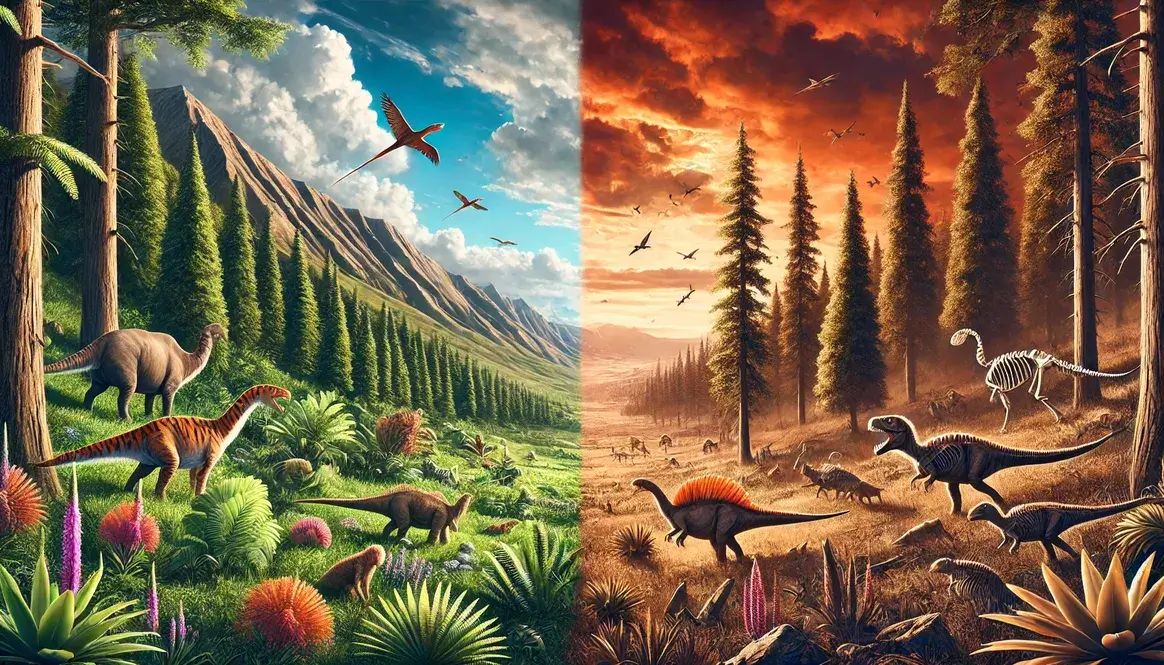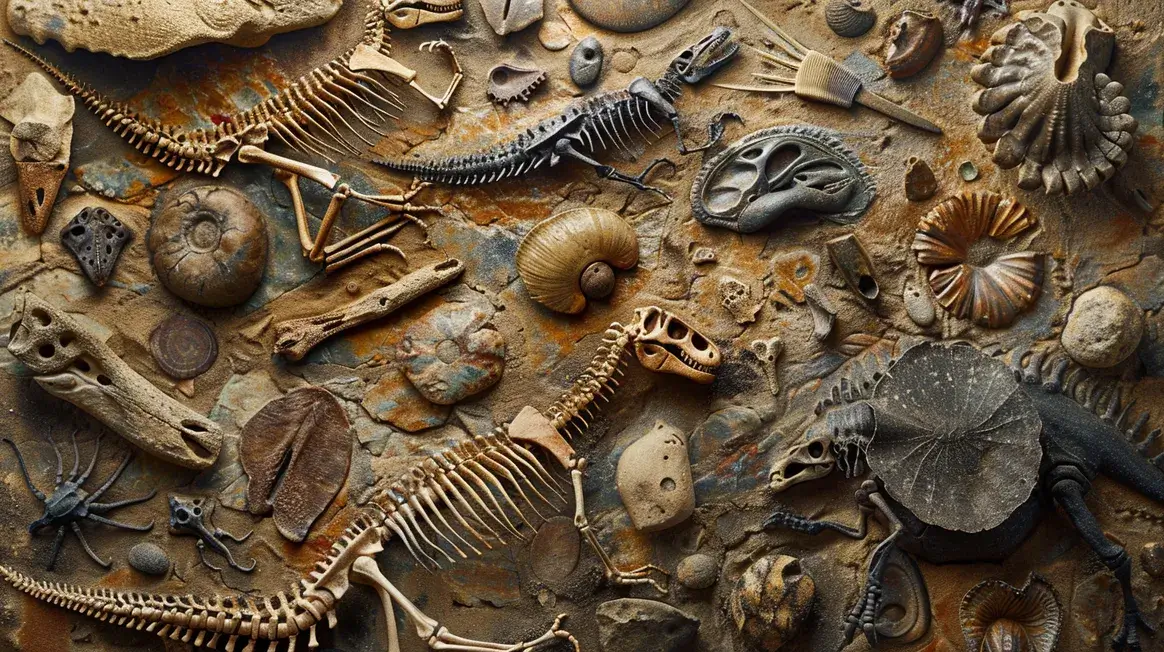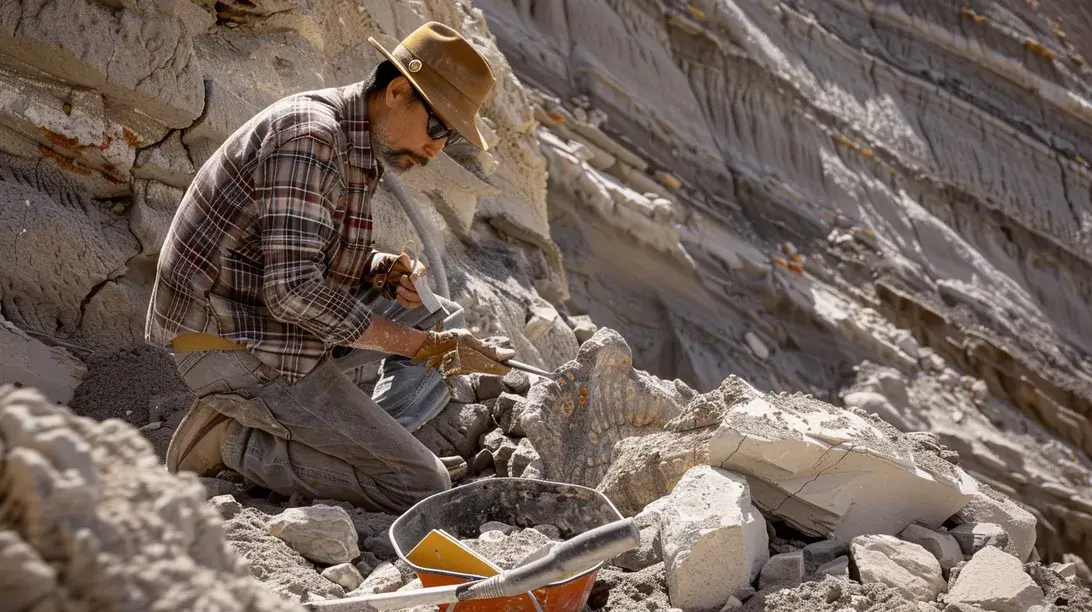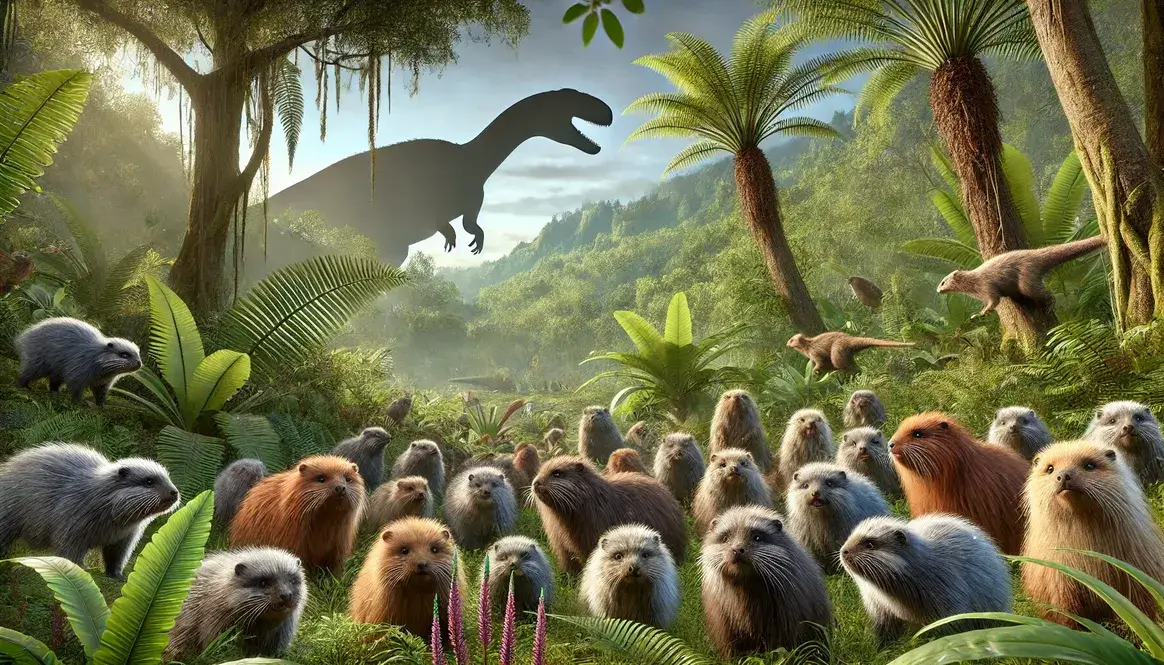The Triassic-Jurassic extinction marks a crucial moment in our planet’s past. This event reshaped life on Earth and set the stage for the rise of dinosaurs in the Jurassic period.
Setting the Stage: Late Triassic World
The Late Triassic period, about 237 to 201 million years ago, was a world unlike our own. Imagine a time when all the continents were joined together in a supercontinent called Pangaea. This massive landmass was surrounded by a vast ocean called Panthalassa.
Life in the Late Triassic was diverse and thriving. On land, early dinosaurs were just beginning to appear, but they weren’t the dominant creatures yet. Instead, the landscape was ruled by other reptiles:
- Pseudosuchians: Relatives of modern crocodiles, these animals came in various shapes and sizes.
- Rhynchosaurs: Herbivorous reptiles with beaked mouths for crunching tough plants.
- Dicynodonts: Large, mammal-like reptiles with tusks.
In the seas, life was equally varied. Prehistoric marine reptiles like ichthyosaurs and plesiosaurs swam alongside fish and early sharks. The oceans were also home to ammonites, shellfish with spiral shells that were distant relatives of today’s squids and octopuses.
The Triassic-Jurassic Extinction Event
The Triassic-Jurassic extinction, also known as the end-Triassic extinction, was one of the “Big Five” mass extinctions in Earth’s history. It occurred about 201.3 million years ago, marking the boundary between the Triassic and Jurassic periods.
This wasn’t a quick event like an asteroid impact. Instead, the extinction process likely lasted between 10,000 to 100,000 years. That might seem long to us, but in geological terms, it’s pretty quick!
The extinction wasn’t limited to one area. It affected life across the globe, both on land and in the oceans. About 76% of all species on Earth went extinct during this time. That’s more than three out of every four species!
Proposed Causes of the Extinction
Scientists have proposed several reasons for this mass extinction. Let’s explore the main theories:
Volcanic Activity: Central Atlantic Magmatic Province (CAMP)
The leading theory points to massive volcanic eruptions in an area called the Central Atlantic Magmatic Province (CAMP). These weren’t your average volcanoes. The CAMP covered an area of about 11 million square kilometers – that’s larger than the United States!
These eruptions lasted for about 600,000 years, with intense periods of activity. They released huge amounts of lava, ash, and gases into the atmosphere. This had severe effects on the environment:
- Global Warming: The gases released, especially carbon dioxide, trapped heat in the atmosphere, causing global temperatures to rise.
- Acid Rain: Sulfur dioxide from the eruptions mixed with water in the atmosphere, creating acid rain that damaged ancient plant life and acidified the oceans.
- Reduced Sunlight: Ash and aerosols in the atmosphere blocked sunlight, potentially causing a period of global cooling before the warming took hold.
Climate Change
The volcanic activity led to significant climate changes:
- Global Warming: Temperatures may have increased by 3-6°C globally. This warming could have been too rapid for many species to adapt.
- Ocean Changes: The oceans absorbed much of the extra carbon dioxide, making them more acidic. This was particularly hard on marine life with shells, like ammonites.
Warmer oceans also held less dissolved oxygen, making it harder for marine life to breathe. Changes in ocean currents could have disrupted food chains and breeding patterns.
Other Potential Factors
While volcanic activity and climate change are the main suspects, scientists have considered other factors:
- Sea-Level Changes: As the climate warmed, ice sheets melted, causing sea levels to rise. This could have flooded coastal habitats and changed ocean chemistry.
- Extraterrestrial Impact: Some scientists have suggested an asteroid or comet impact might have played a role, similar to the extinction of the dinosaurs. However, evidence for this is limited compared to the volcanic theory.
| Factor | Evidence | Impact |
|---|---|---|
| Volcanic Activity (CAMP) | Extensive lava flows, matching timeline | Strong – Main driver of climate change |
| Climate Change | Carbon isotope records, fossil evidence | Strong – Direct impact on ecosystems |
| Sea-Level Changes | Geological records | Moderate – Affected coastal areas |
| Extraterrestrial Impact | Limited geological evidence | Weak – Not widely accepted |
As we can see, the Triassic-Jurassic extinction was a complex event with multiple factors at play. Understanding these past events helps us appreciate the delicate balance of life on Earth and the potential impacts of rapid environmental change.
This extinction event set the stage for the rise of new species in the Jurassic period, including the emergence of large sauropod dinosaurs and fearsome Jurassic predators. The aftermath of this extinction would shape life on Earth for millions of years to come, leading to the diverse ecosystems of the Jurassic period and beyond.
Victims of the Extinction
The Triassic-Jurassic extinction event was a catastrophic time for life on Earth, affecting both land and sea creatures. Let’s explore the major groups that fell victim to this great dying.
Marine Organisms
The oceans took a severe hit during this extinction event. Many marine species couldn’t adapt quickly enough to the rapidly changing conditions.
- Conodonts and their complete extinction
Conodonts, small eel-like creatures with tooth-like structures, had been around for about 300 million years. Sadly, they couldn’t survive the Triassic-Jurassic extinction. These animals, which scientists often use to date rocks, vanished completely from the fossil record.
- Impact on marine reptiles
Many prehistoric sea monsters struggled during this time. Some species of ichthyosaurs and plesiosaurs faced significant losses. However, not all of them went extinct. Some managed to survive and even thrive in the Jurassic seas that followed.
Terrestrial Vertebrates
On land, the extinction hit certain groups particularly hard.
- Non-crocodylomorph pseudosuchians: These ancient relatives of crocodiles were diverse and successful during the Triassic. However, most of them didn’t make it through the extinction event. The only pseudosuchians that survived were the crocodylomorphs, ancestors of modern crocodiles and alligators.
- Early dinosaur groups: While many people think the Triassic-Jurassic extinction paved the way for dinosaurs, some early dinosaur groups were also affected. However, the extinction of their competitors allowed surviving dinosaur groups to diversify and dominate in the Jurassic period.
Plant Life
Plants, the foundation of terrestrial ecosystems, weren’t spared from the extinction event. Many Triassic plant groups suffered, with seed ferns declining significantly. This change in plant life would have had knock-on effects on the herbivores that depended on them.
In the oceans, certain groups of phytoplankton were hit hard. These tiny organisms form the base of marine food chains, so their loss would have had far-reaching consequences for ocean ecosystems.
Survivors and Adaptations
Despite the severity of the extinction, some groups managed to survive and even thrive in its aftermath.
Groups that survived the extinction
Several key groups made it through the extinction event:
| Survivor Group | Notable Features |
|---|---|
| Crocodylomorphs | Ancestors of modern crocodiles and alligators |
| Mammals | Small, nocturnal creatures that would later evolve into a diverse group |
| Turtles | These armored reptiles proved resilient to the changing conditions |
| Some dinosaur groups | Including ancestors of both herbivorous sauropods and carnivorous theropods |
Adaptations that may have aided survival
Survivors of the extinction likely had certain traits that helped them endure:
- Adaptability: Animals that could eat a variety of foods or live in different habitats had a better chance of survival.
- Small size: Smaller animals generally need less food and can hide more easily. This may explain why early mammals of the Jurassic were mostly small.
- Efficient breathing: Animals with more advanced respiratory systems, like some dinosaurs, may have coped better with changes in atmospheric oxygen levels.
Heat regulation and burrowing behavior were also crucial adaptations. Animals that could regulate their body temperature or shelter underground might have been protected from extreme temperatures and environmental changes.
These survivors would go on to shape the ecosystems of the Jurassic period, leading to new and diverse forms of life. The extinction event, while devastating, set the stage for the age of dinosaurs and the evolution of many modern animal groups.
The Early Jurassic: Recovery and Diversification
After the Triassic-Jurassic extinction event, life on Earth entered a period of recovery and remarkable diversification. This era, known as the Early Jurassic, saw the emergence of new species and the reshaping of global ecosystems.
Timeline of ecosystem recovery
The recovery of life after the extinction wasn’t instant. It took time for ecosystems to stabilize and new species to evolve. Here’s a simplified timeline:
| Recovery Phase | Time Frame | Key Characteristics |
|---|---|---|
| Immediate aftermath | First few thousand years | • Dominated by disaster species like ferns • Low diversity in both marine and terrestrial environments |
| Early recovery | 10,000 – 100,000 years after | • Gradual return of more complex plant life • Slow increase in animal diversity |
| Mid recovery | 100,000 – 1 million years after | • Establishment of new food chains • Rapid diversification of surviving groups |
| Late recovery | 1-10 million years after | • Ecosystems reach new equilibrium • Emergence of uniquely Jurassic fauna and flora |
Emergence of new species and groups
The Early Jurassic saw an explosion of new life forms, filling the ecological niches left vacant by the extinction. Some notable developments include:
- Dinosaurs: With many of their competitors gone, dinosaurs underwent rapid diversification. This period saw the rise of early sauropods and the ancestors of later famous groups like Stegosaurs.
- Marine reptiles: New species of ichthyosaurs and plesiosaurs evolved, adapting to the changing ocean environments. These Jurassic sea monsters would dominate the oceans for millions of years.
- Early mammals: Though still small and mostly nocturnal, early Jurassic mammals began to diversify, laying the groundwork for their later success.
- Plants: New groups of conifers and cycads appeared, and the first flowering plants (angiosperms) may have emerged during this time.
Changes in global ecosystems post-extinction
The Early Jurassic world looked quite different from the late Triassic:
- Terrestrial ecosystems
- Dominated by conifers and other gymnosperms
- Dinosaurs became the primary large land animals
- Forests were less diverse but more extensive
- Marine ecosystems
- New reef systems developed, dominated by different organisms
- Ammonites and belemnites became abundant
- Bony fish began their rise to dominance
- Climate and geography
- The Jurassic climate was generally warmer and more humid than today
- Pangaea began to break apart, creating new coastlines and inland seas
These changes set the stage for the incredible diversity of life in the Jurassic period. The recovery and diversification following the Triassic-Jurassic extinction demonstrate the resilience of life on Earth, even in the face of catastrophic events.









